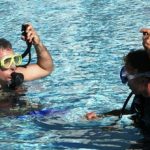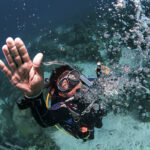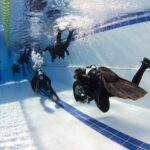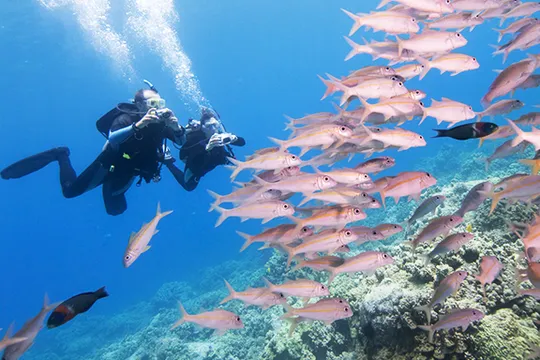What’s It Like To Breathe Underwater?
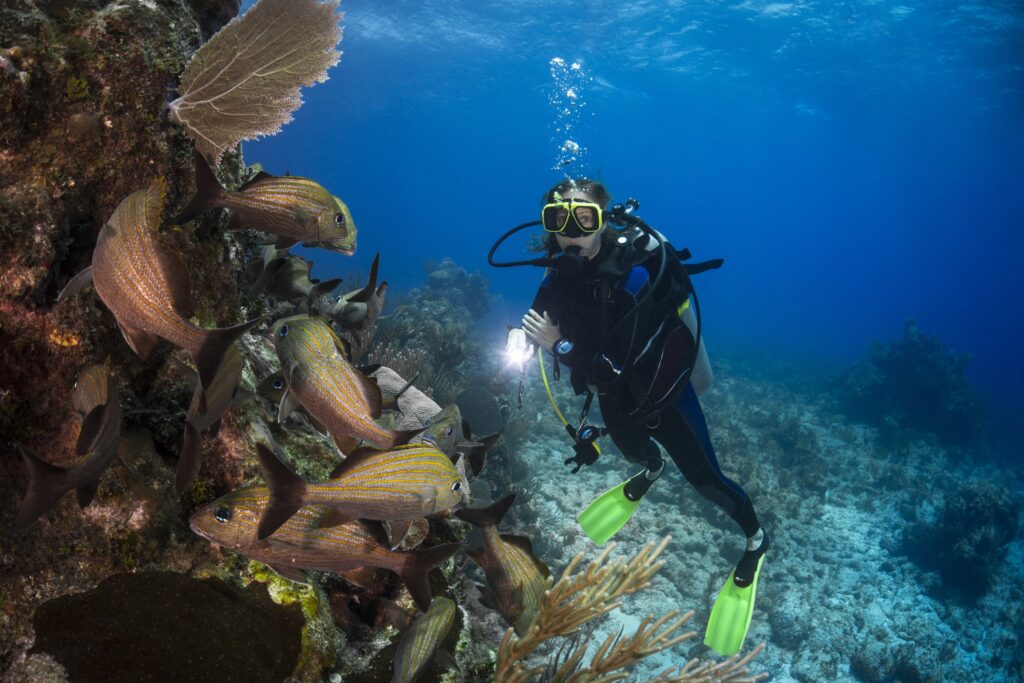
Scuba diving is swimming underwater with the help of a self-contained underwater breathing apparatus (SCUBA). This is typically a tank of compressed air.
Breathing underwater unaided is of course impossible for humans. The oxygen content of water is too low – air has about 20 times more oxygen in it than the same volume of water – and water is too dense to easily move in and out of our lungs. The very idea of taking a breath while submerged is so foreign to us that people who have never experienced it tend to wonder what it is like.
Breathe Easy
The first thing to know about breathing underwater is that it is easy. This is because the air in a scuba tank is compressed. By the way, the proper term for a scuba tank is cylindrical pressure vessel. A tank is an unpressurized container like the fuel tank on a car, but nearly all divers use SCUBA tank or dive tank to refer to the cylinder and valve system they rely on for air.
Dive tanks come in wide range of air capacities and pressure capabilities. The tanks used for sport diving are commonly found in low (2400 to 2640 psi), standard (3000 psi), and high (3300 to 3500 psi) pressure capacities. When a diver pulls in a breath through a regulator, air comes from a supply in the hose connected to the first stage, which has lowered the pressure from tank pressure to about 140 psi. The second stage, held in the diver’s mouth, has a mechanism that further lowers the air pressure to ambient levels so it is comfortable to breathe.
The air supply feels plentiful, with more always available to enter the mouth piece effortlessly. There is no feeling of having to struggle or suck air into the lungs when diving unless the tank is nearly empty.
Keep Breathing
Another important difference related to breathing underwater while diving is that a diver should breathe in and out smoothly and continuously. There should be no pausing in between breaths because the first rule of diving is to never hold your breath. If a diver ascends even a few feet while holding a breath, the air in the lungs will expand and serious injury could result.
That’s why practicing yogic breathing on dry land is excellent for dive conditioning. Like yoga, diving requires us to breathe consciously, the opposite of the way we normally do on dry land. Deep, slow breaths help to extend bottom time. This style of breathing also adds to safety while diving by preventing hyperventilation and having a calming effect on the diver.
Breathing Underwater is Fun
Finally, most people think that breathing underwater is fun and interesting. It is such an unusual act that there is a novelty effect. Underwater breathing is also what lets us enjoy unique environments that we could never enter otherwise, so divers connect it with generally positive experiences. Many people report that breathing underwater gives them a serene, relaxed feeling. This could be a simple side-effect of breathing slowly, calmly, and deeply.
It is easy to find out for yourself what it is like to breathe underwater. Simply come to Key West and learn to scuba dive. You will soon be breathing underwater on your own Key West scuba diving adventure.
- Special Offer
 Special Offer
Special OfferGo deeper into the world of Scuba with PADI® Advanced Open Water Diver certification. Expand your skills and experience, qualify for pro-level dive training.
2 days (approx.) Free Cancellation Instant Confirmation$699
$659$699
$659 
Before Looking for a Great Adventure in Key West? Enter the amazing world of scuba diving the fun and easy way with PADI® Open Water
2 days (approx.) Free Cancellation Instant ConfirmationBest Rate
$499Best Rate
$499
The is the absolute best way for a person to experience diving. Great for those who want to try scuba diving in Key West.
9 hours (approx.) Free Cancellation Instant Confirmation$269
$229$269
$229- Special Offer
 Special Offer
Special OfferA Dive Refresher course from Key West Scuba Diving is a safe, fun pool session review of basic scuba skills. Certified divers who have been
8 hours (approx.) Free Cancellation Instant Confirmation$229
$225$229
$225 - Special Offer
 Special Offer
Special OfferGo Key West night diving and experience nightime on the coral reef on a Key West Scuba Diving 1-Tank Key West Night SCUBA Dive. A
2 hours 30 minutes (approx.) Free Cancellation Instant Confirmation$169
$149$169
$149 
Afternoon two-tank Key West Scuba dive trips offer divers the chance to explore two different dive sites on the pristine coral reef system of the
4 hours 30 minutes (approx.) Free Cancellation Instant ConfirmationBest Rate
$99Best Rate
$99
Try one of the top Key West dive trips – A morning 2-tank wreck dive on the 525-foot USNS Vandenberg, a WWII-era troop transport &
4 hours 30 minutes (approx.) Free Cancellation Instant ConfirmationBest Rate
$99Best Rate
$99

